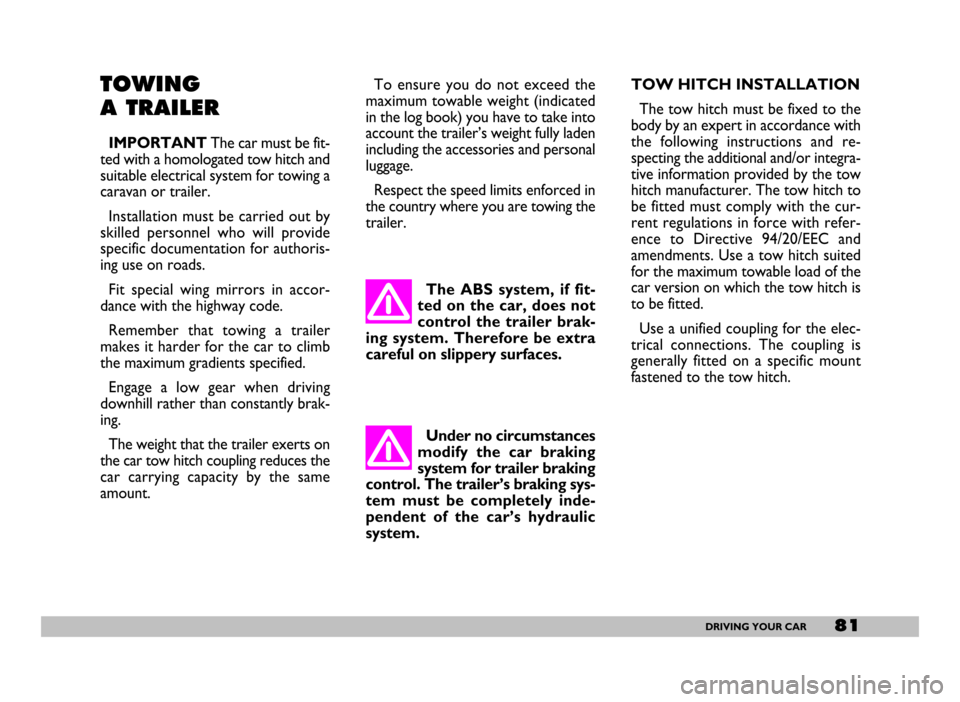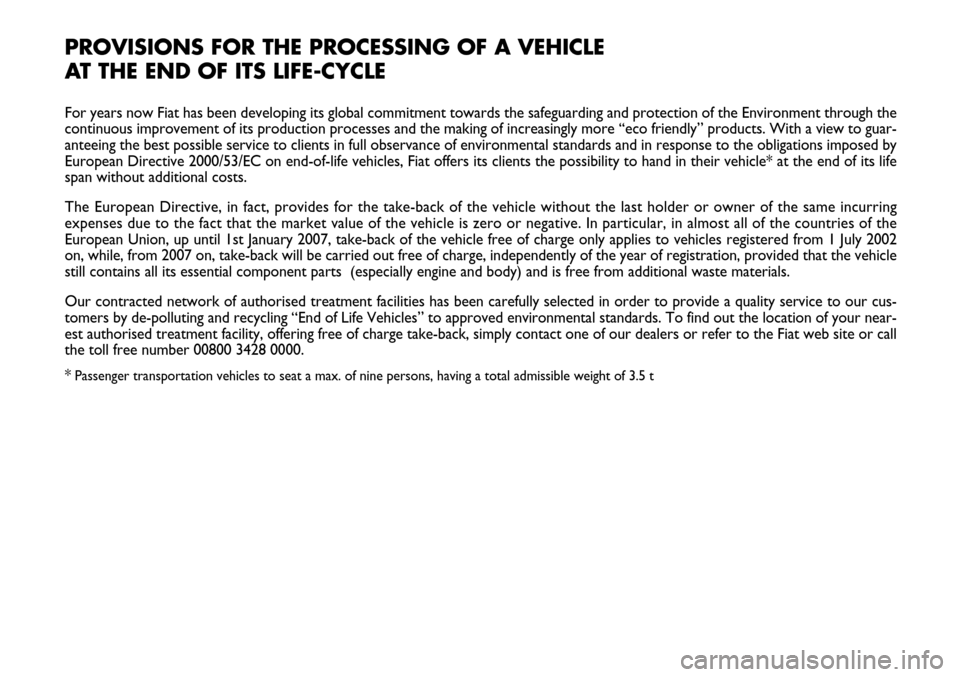2007 FIAT SEICENTO weight
[x] Cancel search: weightPage 82 of 154

81DRIVING YOUR CAR
TOWING
A TRAILER
IMPORTANTThe car must be fit-
ted with a homologated tow hitch and
suitable electrical system for towing a
caravan or trailer.
Installation must be carried out by
skilled personnel who will provide
specific documentation for authoris-
ing use on roads.
Fit special wing mirrors in accor-
dance with the highway code.
Remember that towing a trailer
makes it harder for the car to climb
the maximum gradients specified.
Engage a low gear when driving
downhill rather than constantly brak-
ing.
The weight that the trailer exerts on
the car tow hitch coupling reduces the
car carrying capacity by the same
amount. To ensure you do not exceed the
maximum towable weight (indicated
in the log book) you have to take into
account the trailer’s weight fully laden
including the accessories and personal
luggage.
Respect the speed limits enforced in
the country where you are towing the
trailer.TOW HITCH INSTALLATION
The tow hitch must be fixed to the
body by an expert in accordance with
the following instructions and re-
specting the additional and/or integra-
tive information provided by the tow
hitch manufacturer. The tow hitch to
be fitted must comply with the cur-
rent regulations in force with refer-
ence to Directive 94/20/EEC and
amendments. Use a tow hitch suited
for the maximum towable load of the
car version on which the tow hitch is
to be fitted.
Use a unified coupling for the elec-
trical connections. The coupling is
generally fitted on a specific mount
fastened to the tow hitch. The ABS system, if fit-
ted on the car, does not
control the trailer brak-
ing system. Therefore be extra
careful on slippery surfaces.
Under no circumstances
modify the car braking
system for trailer braking
control. The trailer’s braking sys-
tem must be completely inde-
pendent of the car’s hydraulic
system.
Page 129 of 154

128TECHNICAL SPECIFICATIONS
T T T T
E E E E
C C C C
H H H H
N N N N
I I I I
C C C C
A A A A
L L L L
S S S S
P P P P
E E E E
C C C C
I I I I
F F F F
I I I I
C C C C
A A A A
T T T T
I I I I
O O O O
N N N N
S S S S
IDENTIFICATION DATA
CHASSIS MARKING
This is stamped on the bed plate in
the boot, on the right fig. 1.
It can be seen by lifting the carpet
and includes:
– vehicle model ZFA 187000
– chassis number.ENGINE MARKING
The marking is stamped on the cylin-
der block and includes the model and
the serial number.
MODEL PLATE
The plate fig. 2 bears the following
identification data:
A - Manufacturer’s name
B - Homologation number
C - Vehicle type code
D - Chassis numberE - Maximum vehicle weight fully
loaded
F - Maximum vehicle weight fully
loaded with trailer
G - Maximum vehicle weight on
front axle
H - Maximum vehicle weight on rear
axle
I - Engine type
L - Body version code
M - Spare part code.
The plate is in the boot, on the left
fig. 3.
fig. 1
P4Q00080
fig. 2
P4Q00081
fig. 3
P4Q00100
Page 139 of 154

138TECHNICAL SPECIFICATIONS
Van
760
450
610
720
1210
400
200
28
30 S - Active
735
465
610
630
1200
400
350
28
30
WEIGHTS
(1) If special equipment is fitted (sunroof, tow hitch etc.) the unladen weight increases, thus reducing the payload as specified in the maximum loads al-
lowed.
(2) The driver is responsible for arranging the load so that it complies with these limits.
Weight empty (including fluids, 90% fuel in the tank and no optional) kg
Payload
(4 occupants + 50 kg or driver + 330 kg) kg
Maximum loads permitted (2):
– front axle kg
– rear axle kg
– fully laden kg
Towable weight:
– trailer with brake kg
– trailer without brake kg
Weight on trailer ball joint kg
Maximum weight on roof kg
Page 149 of 154

148INDEX
Sound system
– aerial ....................................... 64
– installation wiring diagram . 65
– setup system ......................... 66
– speakers ................................. 66
– standard setup ...................... 64
Spark plugs ........................... 130-131
Speedometer .............................. 23
Starting the engine
– emergency startup ............... 71-87
– ignition switch ....................... 22
– jump starting .................. 87-105
– procedure .............................. 70
– stopping the engine ............. 71
– warming up the engine ....... 70
Steering column lock ................ 22
Steering column stalks
– left-hand stalk ....................... 37
– right-hand stalk ..................... 38
Steering ................................. 61-133
Storing the car ............................ 86
Sun visors .................................... 43
Sunroof
– electrical ................................. 43Suspensions ................................. 132
Symbols ........................................ 6
Technical specifications .......... 128
Third brake lights ....................... 100
Tools ............................................. 90
Top speeds .................................. 137
Towing a trailer
– assembly diagram ................. 82
– tow hitch installation .......... 81
– warnings ................................. 81
Towing the car ........................... 107
Transmission ............................... 131
Transporting children
in safety ...................................... 15
Tyre pressure ............................. 136
Tyres
– inflation pressure ................. 136
– maintenance .......................... 120
– replacing a wheel ................. 89
– types ....................................... 135
– winter tyres ........................... 83
Van ............................................. 62
Ventilation ................................... 35
Warning lights ........................ 25
Weights ........................................ 138
Wheel
– maintenance .......................... 120
– replacement .......................... 89
– spare wheel ........................... 134
– types ....................................... 135
Wheel geometry ........................ 134
Windows (cleaning) .................. 126
Windscreen and rear window
wiper blades ............................. 122
Windscreen washer
– control .................................... 38
– fluid level ................................ 116
Windscreen wipers
– blades ...................................... 122
– control .................................... 38
– nozzles .................................... 124
Windscreen/rear window
washer fluid level ..................... 116
Page 150 of 154

PROVISIONS FOR THE PROCESSING OF A VEHICLE
AT THE END OF ITS LIFE-CYCLE
For years now Fiat has been developing its global commitment towards the safeguarding and protection of the Environment through the
continuous improvement of its production processes and the making of increasingly more “eco friendly” products. With a view to guar-
anteeing the best possible service to clients in full observance of environmental standards and in response to the obligations imposed by
European Directive 2000/53/EC on end-of-life vehicles, Fiat offers its clients the possibility to hand in their vehicle* at the end of its life
span without additional costs.
The European Directive, in fact, provides for the take-back of the vehicle without the last holder or owner of the same incurring
expenses due to the fact that the market value of the vehicle is zero or negative. In particular, in almost all of the countries of the
European Union, up until 1st January 2007, take-back of the vehicle free of charge only applies to vehicles registered from 1 July 2002
on, while, from 2007 on, take-back will be carried out free of charge, independently of the year of registration, provided that the vehicle
still contains all its essential component parts (especially engine and body) and is free from additional waste materials.
Our contracted network of authorised treatment facilities has been carefully selected in order to provide a quality service to our cus-
tomers by de-polluting and recycling “End of Life Vehicles” to approved environmental standards. To find out the location of your near-
est authorised treatment facility, offering free of charge take-back, simply contact one of our dealers or refer to the Fiat web site or call
the toll free number 00800 3428 0000.
*
Passenger transportation vehicles to seat a max. of nine persons, having a total admissible weight of 3.5 t